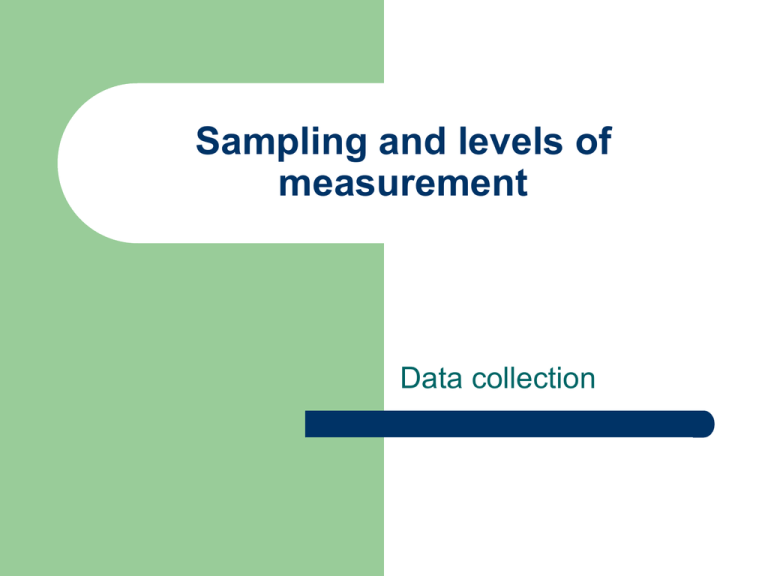Sampling and levels of measurement
advertisement

Sampling and levels of measurement Data collection Sampling terms Population: all subjects one is interested in. Very large or very small Element Sample: portion of population Sampling frame: list of people (elements) in the population Sampling Representative sample: if the overall characteristics of the sample approximate the important characteristics of the population Biased sample: not representative Why sample? time and money Terms Parameters and statistics Parameters: population Statistics: samples Sampling in the U.S. Literary Digest polls. Accurate until 1936, when Landon was predicted as winner of the presidential election Reasons: (1) low return rates (2 million out of 10 million) and (2) sampling frame (telephone directories and lists of auto owners) Poor sampling frames result in bias Sampling in the U.S. 1948 Gallup poll predicted Dewey would win. Problems: (1) stopped polling in Oct.; (2) quota sampling Two types of sampling: probability and nonprobability sampling Probability sampling uses the laws of probability, whereas non-probability does not Probability p = number of times an event could occur / total number of outcomes. Can be expressed as a fraction, a %, as chances out of 100, or as a decimal. P can range from 0 (no probability to 1 (certainty) Sampling A sample will be more likely to be representative of a population from which it is selected if all members of the population have an equal chance of being selected in the sample Sampling Sampling error: error due to the fact that the sample is not representative Necessity of a complete sampling frame Probability sampling Simple random sampling: (out of a hat, random numbers) Systematic random sampling: every nth element is cnosen, select first element at random (random start) Probability sampling Stratified random sampling 1. Divide sample into subgroups based on important population characteristics 2. Randomly sample from those subgroups in proportion to their percentage in the population Probability sampling Choice of stratification variables will often depend on what variables are available, and how much is known about the population This technique most likely to be representative Non-probability sampling Probability sampling only works if there is a sampling frame of the population. Sometimes that is not possible (i.e., criminals, drug addicts, etc.) Nonprobability sampling methods, while running the risk being unrepresentative might be the only option Non-probability sampling Convenience: the captive audience College students and prisoners Purposive: researcher uses judgment For example, the mentally ill. Works best if the criteria for inclusion are clear Quota: like stratified random. Groups are selected on the basis of known variables In quota sampling, subjects are not selected randomly--subjects with the desired characteristics are selected until a quota is filled for each subgroup Non-probability sampling Snowball: each subject is asked to suggest other subjects Tips about sampling Sample size: unusually the number of subjects needs to be at least 30. If several groups within the sample are to be compared, there needs to be at least 10 per group. The larger the number of subjects (N), the less likely sampling error Tips about sampling There will always be “mortality” Samples should be larger to take this into account Tips about sampling The greater the heterogeneity of the sample, the larger the sample must be. The less population diversity, the smaller N might be. N is often determined by time and money factors Levels of measurement Nominal And Ordinal (nonparametric) Interval And Ratio (parametric) Nominal Nominal: lowest level, simply classifying observations into categories Categories should be mutually exclusive and exhaustive Examples: gender, major, religion, state Nominal (continued) Numbers assigned to the categories have no numerical meaning. Assign individuals, and report the % falling into each category. Fewer statistical techniques can be used Ordinal measurement Ordinal measurement: one observation represents more of a given variable than another observation Rankings Newly developed tests Ordinal (continued) Ranks tell whether one observation represents more or less than another, but not how much more or less--nothing is known about the exact difference between any two ranks Rankings of crime seriousness Interval Interval: like an ordinal scale, but has equal intervals between the units of measurement. Not only an ordering, but also the same distance or degree of difference between observations For example, 81 is 1 point away from 80, etc. Well-developed tests are interval level With interval measurement, can do addition, subtraction, multiplication and division, more statistical tests Ratio measurement Ratio measurement: like interval, with the additional property of a true zero. An individual could have two or three time as much of a trait as another with ratio measurement Ratio Height or weight. A 200 lb person weighs twice as much as a 100 pound person Not true for interval. For example, no such thing as an IQ of 0, and a person with an IQ of 100 is not twice as smart as someone with an IQ of 50 Determining statistical test 1 sample Nominal Ordinal Interval 2 samples >2 samples Chi square MannKruskalWhitney Wallis independent samples; Wilcoxin (related samples) T-tests ANOVA









